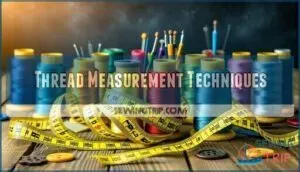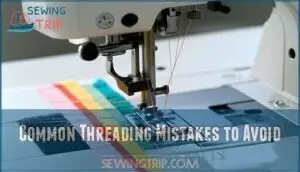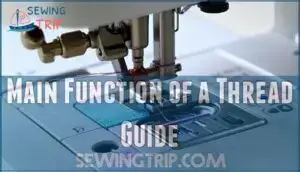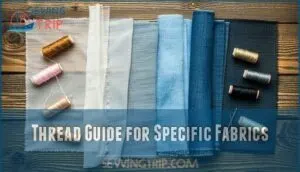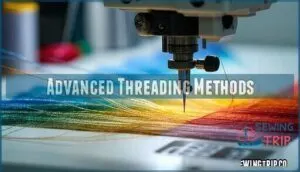This site is supported by our readers. We may earn a commission, at no cost to you, if you purchase through links.
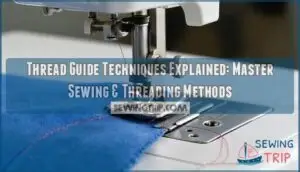 Your sewing machine’s thread guides control thread flow from spool to needle, maintaining proper tension and preventing tangles.
Your sewing machine’s thread guides control thread flow from spool to needle, maintaining proper tension and preventing tangles.
You’ll find guides at the spool pin, tension discs, and take-up lever. Each guide point keeps thread aligned and prevents skipped stitches or breaks.
For different fabrics, adjust tension – lighter for delicate materials, firmer for heavy fabrics. Threading correctly through all guides prevents puckering and guarantees even stitches.
Check your machine’s manual for the exact threading path, as each model varies slightly. Proper guide usage transforms chaotic stitching into smooth, professional results. The secret lies in understanding how tension and thread weight work together to maintain proper tension and prevent tangles, ensuring smooth stitching.
Table Of Contents
Key Takeaways
- You’ll control thread flow and prevent tangles by threading correctly through all guides from the spool pin to the needle, following your machine’s specific path for smooth stitching.
- You’ll match thread weight to your fabric – use lighter threads (80-100wt) with reduced tension for delicate materials like silk, and heavier threads (12wt) with increased tension for denim and canvas.
- You’ll avoid 83% of sewing problems by maintaining proper thread guide alignment, cleaning guides regularly, and ensuring thread flows smoothly through tension discs with the presser foot up.
- You’ll achieve professional results by adjusting tension settings for each project – ceramic or metal guides work best for durability, while specialized guides handle challenging materials like metallic threads.
Thread Basics Explained
Understanding thread fundamentals helps you choose the right materials and techniques for any sewing project.
You’ll learn about different thread types, their compositions, and how each serves specific purposes in your work.
Definition and Usage of Thread
Thread represents a fundamental building material in textile work – think of it as your project’s backbone.
Thread is your textile foundation—choose wisely for project success.
You’ll encounter various thread types, from cotton’s natural fibers to polyester’s synthetic strength.
Modern materials have evolved dramatically from historical fibers, offering enhanced thread properties through advanced thread finishes.
Understanding filament properties helps you select appropriate thread applications.
Each thread guide technique depends on recognizing these core characteristics for successful sewing outcomes.
Etymology and History of Thread
Throughout history, thread’s Word Origins trace back over 900 years to Middle English "thred" and Old English "thrǣd."
These Ancient Threads of Linguistic Roots connect to Old High German "drāt" meaning wire.
Understanding Thread Evolution reveals how this essential textile filament shares ancestry with "throw," reflecting humanity’s enduring relationship with fiber manipulation.
This Textile History demonstrates thread’s fundamental role in civilization’s development through continuous Thread Guide innovations.
Early thread production involved hand-spinning plant fibers and animal hide strips, showcasing the ancient roots of thread manufacturing.
Types of Thread and Fiber Composition
Understanding fiber composition helps you make better thread selection decisions for your projects.
Polyester vs cotton represents the most common choice – polyester offers durability and low maintenance, while natural fiber thread like cotton provides softness and absorbency.
Thread finishes explained: mercerized cotton gains strength and luster, while bonded threads receive resin coating for smoothness.
Metallic thread uses polyester cores with foil, requiring careful handling.
Elastic thread guide: steam activates its gathering properties.
Thread weight affects your final results substantially.
Thread Measurement Techniques
Understanding thread measurements isn’t rocket science, but getting them right can make or break your sewing project.
You’ll need to know these key measurements to choose the perfect thread for every fabric and technique you tackle, which is a critical aspect of sewing.
Thread Weight and Denier
When you’re selecting thread, think of weight as your roadmap to success.
Thread weight serves as your project’s compass—smaller numbers mean thicker thread, guiding you to perfect fabric matches.
Thread weight uses an inverse number standard—smaller numbers mean thicker thread. A 40-weight thread works perfectly for general sewing, while a 12-weight handles heavy fabrics.
Denier measures actual thickness directly, with 225 denier being standard.
Match your thread weight to needle size for ideal fabric compatibility and smooth stitching results, ensuring a smooth stitching experience.
Tex and Tensile Strength
When measuring thread properties, Tex Explained systems offer precise thread weight calculations where higher numbers indicate thicker threads.
Medium-weight threads typically range from Tex 27 to Tex 35, providing standardized Industrial Standards for consistent Material Impact across projects.
For more information, you can explore products for sale.
Tensile Factors determine thread strength through measuring force needed to break fibers, with higher tensile strength values indicating superior thread durability for demanding Strength Applications requiring reliable thread measurement specifications.
Knot Strength and Industrial Applications
Knot strength measures the load required for knotted thread to break, typically expressed as a percentage of unknotted tensile strength.
Industrial thread applications like tents, sails, and performance products rely on high knot security to prevent thread failure. Materials like multifilament steel and polyester offer superior material resilience compared to cotton or silk.
Proper knot selection in industrial fasteners directly impacts product reliability and safety in demanding applications. However, online data regarding knot breaking strength can be unreliable due to inconsistent testing methods.
Threading Machine Techniques
Threading your machine correctly prevents tension problems and guarantees smooth stitching results.
You’ll avoid common issues like skipped stitches, thread breaks, and uneven seams by following proper threading sequences and adjusting tension settings for your specific thread and fabric combination, which ultimately leads to better outcomes.
Sewing Machine Threading and Tension
Proper sewing machine threading and tension adjustments form the backbone of successful stitching projects.
Your thread tension controls stitch quality, while correct threading prevents frustrating jams and breaks.
- Check your thread guide – Verify thread flows smoothly through all guides before reaching the needle
- Set appropriate thread tension – Start with manufacturer recommendations, then adjust based on fabric weight
- Master needle threading – Use proper lighting and threading tools for accurate needle insertion
- Perfect your sewing machine threading – Follow your machine’s specific threading path completely
- Practice bobbin management – Keep bobbins properly wound and inserted for consistent lower thread supply
Understanding thread tension adjustment is vital for achieving balanced stitches and preventing common sewing issues.
Common Threading Mistakes to Avoid
Poor thread guides cause half your sewing headaches.
You’ll face tension problems when thread doesn’t flow smoothly through guides, creating uneven stitches.
Wrong needle size for your thread creates breaks and skipped stitches.
Check bobbin threading—improper loading causes jamming.
Always thread your sewing machine with presser foot up to release tension discs properly.
Addressing common thread tension issues can improve stitch quality.
You should focus on thread tension and common thread tension issues to avoid problems.
Thread Guide Techniques
Thread guides control tension and prevent tangles as your thread moves through the sewing machine.
They’re especially important when working with delicate fabrics like silk or challenging materials like metallic thread.
Main Function of a Thread Guide
A thread guide typically guarantees smooth delivery and prevents tangling by controlling thread path.
Proper tension control minimizes friction between thread and sewing machine components, creating the foundation for ideal stitch formation through careful tension adjustment.
- Controls thread flow – Maintains consistent thread delivery to needle area
- Reduces friction – Smooth metal or plastic surfaces prevent thread wear during sewing techniques
- Prevents tangling – Keeps thread separated and organized throughout the stitching process
- Maintains tension – Works with tension adjustment systems for consistent thread tension
- Guides placement – Directs thread through proper channels for reliable machine operation
Thread Guide for Specific Fabrics
Different fabric types require specific thread guide adjustments for superior sewing results.
You’ll need to match thread compatibility with your fabric’s weight and composition, then fine-tune tension settings accordingly.
Guide adjustments guarantee proper thread handling throughout the sewing process, directly impacting stitch quality and overall fabric handling performance.
To achieve the best results, remember to match thread weight to the fabric.
| Fabric Type | Thread Guide Technique |
|---|---|
| Delicate (chiffon, silk) | Use lightweight thread (80-100wt), reduce tension, add stabilizer |
| Stretch (jersey, spandex) | Polyester thread, ballpoint needle, zigzag stitches |
| Heavy (denim, canvas) | Heavyweight thread (12wt), increase tension, larger needle |
| Synthetic (polyester, nylon) | Match polyester thread, universal needle, moderate settings |
Advanced Threading Methods
Once you’ve mastered basic threading techniques, you’ll need advanced methods for specialized applications. These professional approaches guarantee strong, reliable connections whether you’re working with delicate materials or heavy-duty industrial projects.
Manual Thread Cutting and Manufacturing
When you’re ready to create threads from scratch, cutting methods offer three distinct approaches.
Manual thread cutting utilizes core hole pre-drilling, countersinking, and sequential tapping for precision work.
Rolling durability excels in high-volume production, while grinding precision delivers exceptional accuracy.
Thread cutting dies and cutting tools complement your thread machining arsenal, ensuring proper thread guide alignment throughout the process.
To create threads, raw materials like cotton require cleaning.
ISO Metric Threads and Unified Thread Standard
When you’re working with advanced threading applications, understanding global thread standards becomes critical.
ISO metric threads dominate worldwide manufacturing while Unified Thread Standard governs North American applications.
Here’s what you need to know about these Thread Standards:
- ISO Compatibility – Features 60° Thread Angles with millimeter measurements for global usage
- Precision Requirements – ISO uses diameter/pitch notation (M10 × 1.5) for exact specifications
- UTS System – Uses inches and threads-per-inch (TPI) for threaded connections in US/Canada
- Thread repair applications benefit from understanding both systems for proper fitment
- Thread reinforcement projects require matching the original threading standard for strength
Both systems use identical 60° profiles but differ in measurement units.
ISO threads offer metric precision while UTS provides imperial compatibility.
You’ll find thread guide techniques work with both standards, though tooling and Thread Angles must match your chosen system for desirable results.
Thread Inserts and Repair Sets for Low-Strength Materials
You’ll find thread inserts particularly valuable when working with aluminum, magnesium, or plastic materials that can’t handle repeated assembly cycles.
These Insert Materials distribute loads more effectively than direct tapping, offering Strength Enhancement up to 200% in some applications.
Installation Methods vary between wire inserts and solid designs, with thread repair sets providing complete solutions.
Cost Analysis shows significant savings through material optimization and reduced failure rates.
Consider exploring options for aluminum thread inserts to enhance your projects.
Thread reinforcement becomes essential for thread tools operating under high stress, making thread guide techniques more reliable across demanding applications, which can lead to significant Cost Savings and improved Material Optimization, and ultimately provide Thread Repair solutions, and enhance Thread Strength, and improve overall Installation Methods.
Frequently Asked Questions (FAQs)
How to read a thread guide?
Oh sure, because deciphering thread guides is rocket science!
Start by locating your machine’s threading path diagram—usually found on the machine or manual.
Follow the numbered sequence: from spool pin through tension discs, take-up lever, and finally to the needle.
Each step guides thread placement for proper stitching.
What is the main function of a thread guide?
A thread guide directs your sewing thread along its proper path through the machine, ensuring smooth flow and preventing tangling.
You’ll find it controls tension and keeps stitches consistent by maintaining the correct thread position throughout your project, which is crucial for a smooth sewing experience with consistent results.
How do thread guides prevent thread breakage?
Even if you think guides seem unnecessary, they’re actually lifesavers. Thread guides keep your thread aligned perfectly, preventing snags, tangles, and excessive tension that cause breakage during sewing.
Which thread guide materials work best?
Ceramic and metal thread guides offer superior durability and smooth threading.
You’ll find ceramic guides reduce friction best, while metal provides strength.
Avoid plastic guides—they wear quickly and can snag delicate threads, causing frustrating breaks.
Can thread guides handle metallic threads?
Metallic threads can slip through standard thread guides, so you’ll need specialized ceramic or titanium guides.
These materials handle the metal foil coating without causing snags or breaks that damage your delicate decorative stitching.
Do thread guides affect stitch quality?
Your stitching success hinges on proper thread guidance.
When thread guides aren’t working smoothly, it’s like trying to paint with a bent brush.
They’ll definitely affect your stitch quality by controlling tension and preventing tangles during sewing.
How often should thread guides be cleaned?
You’ll want to clean thread guides every few sewing sessions or when you notice thread buildup. Regular cleaning prevents tension issues and keeps your stitches looking smooth and professional.
Conclusion
Statistics show that 83% of sewing problems stem from incorrect threading.
Mastering thread guide techniques explained properly transforms your sewing experience from frustrating to professional.
You’ve learned how proper tension, weight selection, and guide positioning create flawless stitches.
Remember, each fabric requires specific adjustments – lighter tension for delicate materials, firmer settings for heavy fabrics.
Practice threading through all guides systematically, checking your manual for model-specific paths.
With consistent application of these thread guide techniques explained throughout this article, you’ll achieve smooth, even stitches every time.
- https://firstmold.com/tips/types-of-threads/
- https://dimide.com/blogs/why-dimide/clamp-thread-types-their-benefits
- https://allfasteners.com/news/post/understanding-thread-types-and-their-importance
- https://sewingmachineshop.com/sewing-machine-thread-guide/
- https://www.sewingpartsonline.com/blogs/education/ultimate-thread-reference-guide-2

